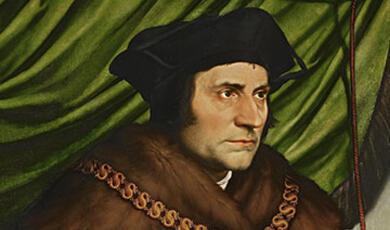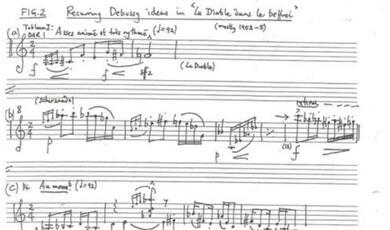The composer virtuoso - Zarebski’s Piano Quintet
Share
- Details
- Transcript
- Audio
- Downloads
- Extra Reading
Music written by composer virtuosi has often been characterised as shallow showpieces. Is this fair, or do some of their works deserve a more prominent place in today's repertoire? One candidate is the little-known Juliusz Zarebski, one of Liszt's favourite pupils and a substantial composer in his own right.
Download Transcript
THE COMPOSER VIRTUOSO – ZAREBSKI'S PIANO QUINTET
Professor Adrian Thomas
The title of today's lecture is the Composer Virtuoso Zarebski's Piano Quintet. A history of the tradition and output of 19th century Virtuosos is long overdue. Most of them have been forgotten or derided or belittled. A few, such as Liszt or Paderewski and, more arguably, Paganini, have survived the scrutiny of history.
In between is a group whose identity remains ambiguous. Were they really virtuosi or were they really composers? And, how are they valued today? This lecture is primarily about the restitution of one work by a musician whose name is not even familiar to the public within his country. The musician is the Polish pianist and composer Juliusz Zarebski. The work in question is his Piano Quintet of 1885, of which I'm a passionate advocate. But, Zarebski's story is an interesting one, in any case, when beginning to assess the lives and times of composer virtuosi.
Paganini has a lot to answer for. For better or for worse, he personified the concept of solo virtuosic display. He also gave rise to the phenomenon of the touring circus. But how does one find out about the lesser figures who disappeared from view? We may look at the history of a little waltz by the publisher Anton Diabelli.
In 1819, Diabelli sent 50 or so leading Austrian composers a request to write a piece on his little waltz that he'd composed. He wanted to compile what he called a patriotic anthology. Of the resulting pieces, only Beethoven's mammoth Diabelli's Variations remains in the repertoire. The New Grove Dictionary of Music, in its recent 2 nd edition says this: 'the variations by the famous piano virtuosos, especially Kalkbrenner, Czerny, Pixis, Moscheles, (NAME 00:02:49 ) and Stadler are, on the whole, brilliant but shallow'. We might ask ourselves how many of those names are in currency today.
Twenty years later, in 1839, Liszt created a similar little book of pieces called Hexameron, 6 variations on a theme from the March from Bellini's 'I Puritani' and he called them Grande Bravoure Variations. And, the composers that he got together, in addition to himself, were Chopin, Czerny, and 3 other virtually forgotten figures: Thalberg, Pixis and Herz.
And then, when we look at the end of the 19th century, we ask ourselves, what has been the fate of major figures such as Godowsky or Busoni's versions of Bach.
Of course, the virtuosi had to tour. It was the vein of their lives and the bread and butter of their careers. If we take the life and work of Henryk Wieniawski, as an example, he was one of the most distinguished violinists and composer virtuosi of the time and his name is still current, we can still find his work in the record shops. He was Polish so his compositions reflect his nationality during the time of partition. And, when he was still only 17 years old, he wrote one of his best known pieces, 'The Polonaise in D'.
That is a very good example, I think, of the type of virtuosic nationalism which was very current, particularly in the 30s, 40s and 50s during the 19th century. It has an almost politically defiant swagger about it and his life, as a whole, is a very good example of the demands of the career on a composer virtuoso at the time.
For example, when he was still in his late teens, between the ages of 16 and 18, he moved to Russia and gave 200 concerts in the 2 years that he was there, which is a pretty remarkable achievement. In the autumn of 1858, he travelled widely in Europe, including this country, and he gave concerts the length and breadth of the land: in London, Manchester, Brighton, Glasgow, Leeds, Liverpool, Birmingham, Dublin and Belfast. It was the custom in those days. When I was living in Belfast, I was really quite struck by the names of the virtuosi that used to go there in the 19th century: Liszt also went to Belfast. Today it's very hard to get anybody of that standing to go anywhere near the place, even in the period of peace.
1872 to 1874, Wieniawski spent 2 years in the United States on tour and in the first year alone, with his accompanist Anton Rubenstein, he gave 215 concerts; a really quite remarkable schedule so it's small wonder that his inherent heart condition deteriorated under such conditions and he died at age 45 in 1880.
As for his compositions, they are mainly for violin and piano as one would expect but there are also 2 violin concertos which are still performed today. The first of them, obviously the younger piece, was dominated by virtuosity, and the second one reflecting the greater maturity and concept of content and musical form, the one that comes with greater experience. So this pattern of youthful exuberance and mature reflection, I think, is quite typical of these figures.
A second figure is Xaver Scharwenka. His name is known but his music, far less so. He was younger than Wieniawski by some 15 years and is a near contemporary of our main focus today, Juliusz Zarebski. And, unlike either of them, he lived the full span; he lived to the ripe old age of 74. Consequently, certainly compared with Zarebski, whose name most of us have never heard of before, his name is at least known if his music is not. So, that's one point in his favour. He also developed a more settled career. The classic example was Liszt; we were looking at with Jim Samson a month ago, where after having done the touring, he then practically settled down, did composing, did a lot of teaching and the same happened to Scharwenka. He even opened his own conservatory in Berlin in 1881 and took up conducting. And, such was his span of life, that he was able to cut piano rolls and even make a few acoustical recordings. So, we have some real evidence of what he was like as a player in his later years. And, his output is equally broad. There is an opera, symphony, lots of chamber music for piano concertos.
The first of his five Polish Dances, which he wrote when he was 19 years old, was his passport to fame. Over a million copies were printed in his lifetime and if you think, that was written in 1869, you can imagine what the comparisons with today are in terms of distribution in the printing and how many people really wanted it, and they couldn't photocopy their own illicit copies, for example. So a million, over a million, copies is really quite remarkable.
Scharwenka's Dances are basically a Mazurka, all the 5 in that set have the Mazurka rhythm. Wieniawski was a Polonaise, and so together they reflect both the aristocratic and the peasant strands in Polish folk music. In composing and in playing these pieces, they were simply following in Chopin's footsteps. They were colour pieces; they were insight into what was happening in Eastern Europe and non-Polish or non-Eastern European players would also play them, too, but clearly if you were the composer, it was your party piece.
The other composer I mentioned in the beginning, Paderewski, who was 6 years younger than Zarebski, also had his calling card. It was a piece called 'Minuet in G' and some of you may very well have played that when you were learning the piano. It's not a Polish piece but equally, it was a thing that both characterised him and hung around his neck, as it were, as a bit of a heavy stone as these things tend to do.
One of the main reasons why Zarebski is continuing in obscurity is because he doesn't have such a calling card. He did attempt one or two pieces. It's evident from his work "The Grande Polonaise Opus 6", that Zarebski took up a compositional career with a great deal of seriousness. He started much later than the other composers I've mentioned, in his mid 20's, and he had higher goals then crowd pleasing miniatures. That's not to say that the other composers I've mentioned did not also write piano sonatas and so forth; I don't want to misrepresent their total output. But, this Polonaise, with its ruminative introduction and its sombre tone and lack of flashiness, as well as its larger scale, some 11 minutes long, is reminiscent more of the Chopin and Paganini-Liszt tradition, even though it is dedicated to Liszt.
So, who was this Zarebski? There are very few images of him around.
This year, 2004, is the 150 th anniversary of his birth, so I don't know how many occasions devoted to him are taking place in the world today but I'm sure this is one of the very few. He came from quite a musical family in a place called Zhitomish, which is now know as Zhitomir in Western Ukraine, west of Kiev. He went to the Vienna Conservatory age 16; passed his exams in 2 years instead of 6. He then went in 1873 to St. Petersburg and completed his diploma in 3 months.
In 1874 he concertised in Kiev, in Odessa, in Ukraine and then went to Rome to study with Liszt. There was an 18 month association of lessons and conversations. Liszt had quite a coterie of students around him at all times, but Liszt apparently, according to Polish writers, regarded Zarebski as his favourite pupil, although it's hard to prove.
In 1876, Zarebski gave concerts in Rome, Naples, Constantinople, Warsaw and Paris. His repertoire was really quite serious and it included large scale pieces like 'Brahms's Variations on a Theme of Paganini of 1863'.
But, there is a very curious episode in Zarebski's life; so far, so conventional. In 1878 he became involved in an extraordinary experiment initiated by the brother of Heinrich Wieniawski. Joseph Wieniawski, who was 2 years younger than his brother, was a pianist and teacher of some note but very much in his brother's shadow with regard to public performance. In 1876, Wieniawski designed a new keyboard instrument. Zarebski was introduced to this new piano 2 years later, in the spring of 1878 and devoted 2 months entirely to relearning his keyboard technique and developing a new repertoire for this new instrument. Unfortunately, none of this repertoire seems to have survived.
At the great Paris Exhibition of 1878, Zarebski became an overnight celebrity. He gave a recital on this new piano before an audience of 5000 people and the paper headline the next day read 'Chopin au revoir. Viva Zarebski'. So, what was special about this new invention by Joseph Wieniawski? It had 2 keyboards. That wasn't, in itself, necessarily a strange thing. What was strange about this one is that the 2 keyboards ran in opposite directions. One keyboard is conventional with the treble at the right, bass at the left. The other keyboard has the reverse, with the bass at the right and the treble at the left.
Why bother to do this? Well, according to the New Grove Dictionary of Music, it was to permit the same fingering for the same passages in both hands. If you're playing octaves, your little finger on your left hand and your thumb of your right hand will start the run up so, actually, it's not the same finger. But if you can imagine playing octaves on 2 different keyboards and starting with your little finger you're actually playing in contra motion what you'd normally play in parallel motion. So, you can see why it took him at least 2 months to relearn his technique, because the mindset of a pianist would not expect to have to do that.
We shouldn't be too surprised that this sort of invention took place because the mid 19th century was a wonderful period for the invention of weird and wonderful instruments; actually, right through until the beginning of the 20 th century. We have keyboards which sound like cellos or horns. We have colour keyboards. We have keyboards with different tunings and so forth. So, this was just one of many. If you go to the Brussels Instrument Museum, you will see, for example, a saxophone looking like some sort of hydra. It's got several horns sticking out of the single instrument. There are some extraordinary things that went on in the 19th century and this is just one of these.
The manufacturer, made 6 of these pianos. One still exists, apparently, in Brussels, one was destroyed in Warsaw during the 2 nd World War and this may have been Zarebski's own.
So, after his huge Paris success, Zarebski brought the double keyboard piano to Warsaw and in October, 1878, to this city, to London. But, the phenomenon was short lived, I think, for fairly obvious reasons and it died out. One of these days I really do want to go to Brussels and see what it looks like because it is the most interesting looking instrument. If you're interested in keyboard instruments, there are some keyboard instruments in this country with 2 keyboards but at either end of a frame. I've seen one in Northern Ireland where you basically have a box with one keyboard at one end and one keyboard at the other. It makes 2 piano music into 1 piano music.
That was a slightly unusual episode in Zarebski's life and having gotten it out of his system, he turned to composition and teaching for his remaining years, which, unfortunately, were very few. We're talking about 1878; he died only 7 years later in 1885. He'd been suffering from tuberculosis for a couple of years. He died aged 31, the same age as Schubert, and in 7 years he obviously didn't have much time to compose extensively. So, his output is small, many pieces for solo piano, none of them large scale and one major chamber work, the Piano Quintet.
He'd moved on hugely from the Grande Polonaise which was written in 1880. The piece called 'Les Roses et les Epines', 'Roses and Thorns', was composed in 1883 and illustrates his mercurial ability with the fingers. The finger work is absolutely wonderful and the darting musical motifs, I think, give us a good idea of what he was like as a pianist.
These pieces don't have individual titles; they've simply got speed markings. The first is particularly interesting because it anticipates, rather surprisingly, the sort of impressionistic piano textures that we associate with Debussy's Preludes, for instance, a couple of decades later. In that sense, he was actually moving forward in the small, private way. This was published during his lifetime but I wonder how many people actually heard it?
When you hear it and if you know some of Liszt's music, particularly those where he's trying to give some sort of impression of water or landscape, the Lisztian background is also clear. Sometimes the harmony and the way the music stops and starts is really quite catching.
Let me move on to the Piano Quintet, which is the real focus. This he composed, it was his last completed piece; he composed it between early January and early March, 1885, the year of his death. It was premiered in Brussels on the 30th of April that year and it's dedicated to Liszt. It wasn't published, however, until 1931 which, by my calculation, is 46 years of total obscurity. So, it never had the chance to establish itself within its own contemporary context. And, that's a crying shame because it stands up there with the greats of what is quite a select group of the genre of the Piano Quintet.
If we think back, probably the first best known one is Schumann's Piano Quintet of 1842, Brahms wrote a very famous one 20 years later, Cesar Franck wrote one in 1879, who was 6 years before Zarebski's, and then Dvorak's followed in 1887, 2 years after Zarebski's, Fauré wrote 2 in 1905 and 1921, Elgar wrote one in 1919, Schostakovitch (Shostakovich) wrote one in 1940 and there are others.
You can see that not many composers actually wrote piano quintets; however, many composers did write many quartets and there's a very close relationship, I think, in terms of the sound role between the piano quartet and the piano quintet. If you look at the piano quartet repertoire, we have got examples by Mozart, Mendelssohn, Schumann, Brahms, Dvorak and 2 again by Fauré.
In terms of the musical language and the structure of a Zarebski, 2 of those works stand out. The first of those is the Brahms Piano Quintet, and some commentators in Poland see a very decided modelling of Zarebski's on Brahms's, but as you'll hear, I think it's quite distinct in terms of musical language.
The other work I will draw your attention to is the 1 st of Fauré's Piano Quartets. That was written in 1880, revised in 1883. Fauré was also a pianist composer, although you wouldn't count him as a virtuoso pianist. It's quite possible, given the fact that Zarebski was working Brussels and, no doubt, travelled down to Paris from time to time, that he may have met Fauré and may, indeed, have heard his work. So, those are the 2 works that I would suggest as comparative listening. There are also some strong traces of Chopinesque harmony as the piece develops.
Although there are recordings that are available, they're not that easy to come by.
The opening passage isn't an 'in your face' type of beginning. It's very subtle. We've got a murmuring of the piano, rather like the beginning of the Mendelssohn Violin Concerto, and it's followed by this very potent lyrical theme on the 2 nd violin and viola. It's an early signal of Zarebski's democratic approach to sharing out the musical material. For example, the supportive role of the piano, not 1 st amongst equals by any means.
And what then follows from here is a series of restless, expressive waves, interrupted, resumed. It's very intuitive. One never has the feeling with this piece that it's formulaic. The 2 nd idea in the 1 st subject group, for example, teases us with its meter, we're not exactly sure where the downbeat is. And, you might like to note the galloping idea on the keyboard towards the end.
Coming to the second subject area you will realise that he is intent on not confirming our wishes and expectations. For example, where we come to the end and one would expect a full cadence into the new key of E Flat, he gives it to us but takes it away at the same time. I'm getting a bit technical here but we don't have a firm indication of the tonic core and it moves away, he's constantly restless. If one was being picturesque about it, one might say he knew he was dying and, therefore, that's the urgency about it, but I think that's taking it far too far. It's just part of his way of thinking and when we come to the end of this section, again, he interrupts the flow, allowing it to come to an expected cadence, because he's saving that for later. It's a very beautiful theme.
What you notice an intense emotional drive, the way in which the music is thrusting forward and the same happens through the development of the section; very exciting, great unexpected passages.
What I'd like to concentrate on is the way in which the material comes back at the end. Having exposed this material and worked it through, he doesn't feel a need for any repeatable or reiteration of material and the opening theme lasts 6 bars and its already moving away by the time we get to bar 3, so that he's driving us forward and finally, finally with another little pause towards the end, he gives us what we've been yearning for, for the preceding 8 or 9 minutes. It's a masterpiece of symphonic structure
The 2 nd movement is a conventional one, it's an adagio but it holds a surprise or two, not least because the introduction comes back to you at an unexpected place towards the end. He's playing tricks with our expectations of where the main beats lie. This is a strong trait in 19th century music. We get it in Schumann a lot; we get it in Brahms as well. This then leads into the main theme which is yet another one of those yearning, Polish themes.
This gives a very strong impression of someone with a great deal of emotional content to cross. Once again, it's worth noting the way in which much of the material is given to string instruments, the piano acting as a background. This is not a composer virtuosi intent on exhibiting his own wares but intent on composing something really rather special.
The 3rd movement is a complete contrast and again has this unusual, rhythmic aspect to it. It's like a wild, headlong ride and I'm reminded of Liszt's Mazeppa, the idea of a horse galloping forward or the character of Mephisto or Schubert's Erlkonig. It has that sort of feel about it.
By this stage in the 1880's, we are used to the idea that a composer will try and link movements together. A famous example is, of course, Beethoven's 9 th Symphony, where he quotes from preceding movements. But, there are more subtle ways of doing it with thematic or intervallic types and so forth.
But Zarebski has actually started the finale as if he's gone back to the scherzo and as if it's all double take. The audience is thinking 'have the players got it wrong? They're going back to the Scherzo, we just heard the scherzo, and here we get it again. Not exactly the same but exactly the same theme in the same key.' He's teasing us again and he proceeds, during the course of this finale, to quote from each of the preceding movements, beautifully weaving them in.
So, here's a composer who really knows his craft and, without making it obvious, is actually unifying the composition. But, it has its own character, this, and is a wonderful respite, a very relaxed respite, to what has gone before.
Just as he did in the first movement, before he gets to the coda, he brings in a moment of respite, tantalising us yet again. This time, it's a quotation from the theme from the 2 nd movement. He's actually had the main themes of each of the 3 movements at different places during the course of this finale: at the beginning, during the 1 st section and just before the coda at the end.
Such is the nature of the intervallic material and the way in which it is dealt with. He actually knits them very well. It's seamless in that sense, it doesn't feel forced. When it comes to the actual coda, once again, he begins to let rip and we've got little figures that look like ordinary figures but is, in fact, our main theme for the finale and to crown the entire coda, he comes back to the principal theme, the one with which the work began.
This quintet lasts about 35 minutes, In my view, this is a minor masterpiece and frankly, I think it does stand up there alongside the greats of the piano quintet's repertoire. It also sheds new light on the legacy of the composer virtuosi. There are works out there, hidden works, works that show something different, they're not what we expect. They show, in this particular instance, a composer who knows his craft, is not keen to show off the virtuosic, it is integrated in a very real fashion. I hope sometime in this country performers will take it up in concerts and may be one of the western recording labels will recognise this gem that's been so sadly neglected.
© Adrian Thomas, Gresham College, 16 December 2004
This event was on Thu, 16 Dec 2004
Support Gresham
Gresham College has offered an outstanding education to the public free of charge for over 400 years. Today, Gresham plays an important role in fostering a love of learning and a greater understanding of ourselves and the world around us. Your donation will help to widen our reach and to broaden our audience, allowing more people to benefit from a high-quality education from some of the brightest minds.


 Login
Login






